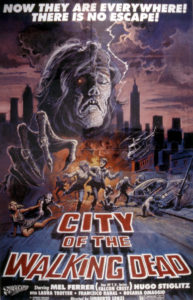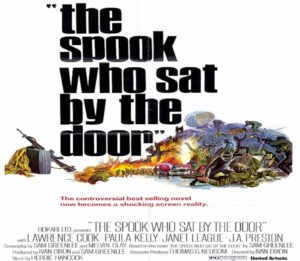Over the years I remembered only a few scenes and that this film had struck me as confused and not good at all and following with this year’s mission of revisiting film that hadn’t worked for me the first time around I was pleased to find it available for streaming on Amazon.
The movie depicts the events as an unnamed city is overrun by the living dead resulting in civilization’s collapse Our main character, though that is using the term quite loosely, is a reporting. He arrives at the airport to interview an atomic scientist. The plane arrives without any communication with the control tower, lands, and the party meeting it is attacked by weapon wielding zombie. Apparently  unlike classic Romero zombie these fellow not only use weapons, clubs and knives, but can pilot aircraft as well. In order to prevent a panic the military gags the reporter, though that turns out to be pointless after the zombie attack a live television broadcast. Throughout the rest of the movie we follow the relations of various military personnel as the outbreak grows worse and the reporter as he and his wife flee the city. Apparently neither of them feel a particularly sense of duty, he as a reporter or she as a friggin’ doctor, and leaving the people of the city to their fates. Because this is an Italian zombie movie there are numerous kills and several involve mutilation to eyes and by the final act the audience is following far fewer characters. Chased by zombie through an amusement park, shades of Zombielanda much better film, the reporter and the doctor climb the rollercoaster. (Because going up always works as an escape route.) A passing military character in a helicopter spots them, hovers overhead with a knotted rope, not even a rope ladder but just a knotted rope like in sadistic middle school P.E. classes, and lowers it to rescues them. The pair climbs but the doctor falls to hear dropped stuffed dummy death and the reporter wakes from his terrible nightmare. Yup, the whole movie has been a dream; they went there. It’s okay they have one more twist left. The reporter goes the airport to interview an atomic scientist and the movie’s opening repeats.
unlike classic Romero zombie these fellow not only use weapons, clubs and knives, but can pilot aircraft as well. In order to prevent a panic the military gags the reporter, though that turns out to be pointless after the zombie attack a live television broadcast. Throughout the rest of the movie we follow the relations of various military personnel as the outbreak grows worse and the reporter as he and his wife flee the city. Apparently neither of them feel a particularly sense of duty, he as a reporter or she as a friggin’ doctor, and leaving the people of the city to their fates. Because this is an Italian zombie movie there are numerous kills and several involve mutilation to eyes and by the final act the audience is following far fewer characters. Chased by zombie through an amusement park, shades of Zombielanda much better film, the reporter and the doctor climb the rollercoaster. (Because going up always works as an escape route.) A passing military character in a helicopter spots them, hovers overhead with a knotted rope, not even a rope ladder but just a knotted rope like in sadistic middle school P.E. classes, and lowers it to rescues them. The pair climbs but the doctor falls to hear dropped stuffed dummy death and the reporter wakes from his terrible nightmare. Yup, the whole movie has been a dream; they went there. It’s okay they have one more twist left. The reporter goes the airport to interview an atomic scientist and the movie’s opening repeats.
Nightmare Citycan be used as an example of how not to write a story. While there are plenty of events going on none of them have any real weight because the people involved are only there to serve the threadbare plot and act as targets. As story more than a sequence of events. People in stories need to have objectives, they need to have motivations that arise from the nature of their characters, and they need to exist in a plot that serves a thematic purpose. Stories have a through line that is more than simple cause and effect. Stories are journeys and journeys imply destinations not just ends. This movie had no journey but mere meandering murders.




